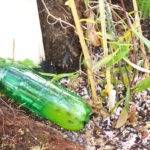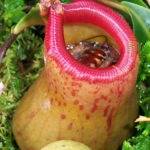The pitcher plants of south-east Asia (Nepenthes) are insect-eaters. They have modified leaves that trap insects by having slippery walls and an overhanging lip (see right). Insects are attracted to the pitcher by its bright colours and the nectar glands that cover the lid and mouth of the pitcher.
Insects trapped in the pitcher are digested by enzymes and provide the plant with a rich source of minerals, normally lacking in the habitats in which they grow.
National Botanic Gardens staff member Karina Penie noticed how the pitchers of Nepenthes merrilliana (right) in the Curvilinear range were trapping very large numbers of cockroaches. These pests cause problems by nibbling the plants at night. At Glasnevin we are committed to integrated pest management – using various predatory insects to deal with pest problems. Therefore using chemicals for control is always a last resort. In the past, sticky traps have been used to catch these insects, but they never did better than trapping one or two in a night.
Using a range of plastic bottles baited with orange juice (below), Karina has been able to catch upwards of 160 in a single trap in one night. The bottles work as simple pit fall traps in exactly the same way as the Nepenthes pitchers.
Karina has undertaken controlled experiments with water, sugar and various natural and artificial fruit juices. She has found that the cheapest varieties of artificial orange juice have been the most successful.


